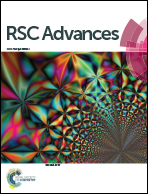Mesenchymal stem cell (MSC) viability on PVA and PCL polymer coated hydroxyapatite scaffolds derived from cuttlefish†
Abstract
In the present study, cuttlefish bones are used to prepare highly porous hydroxyapatite (HA) scaffolds via hydrothermal treatment at 200 °C. Raw cuttlefish bones (CB) and the hydrothermal products have been analyzed and compared for their composition and microstructure, using X-ray powder diffraction (XRD), Optical Microscopy (OM), Scanning Electron Microscopy (SEM), Fourier transform infrared spectroscopy (FTIR), porosity estimation and compressive strength measuring techniques. Characterization reveals that cuttlebone has high porosity approaching above 70%, and possesses the laminar structure of aragonite mixed with some organic materials. The compressive strength of the CB-HA is improved after coating with both polyvinyl alcohol (PVA) and polycaprolactone (PCL). Furthermore, our in vitro biocompatibility studies revealed that CB-HA and PVA coated CB-HA scaffolds are non-cytotoxic and support the adherence and proliferation of rMSCs, comparable to pure HA scaffolds. Altogether, our results suggest that naturally derived CB-HA, PVA and PCL coated CB-HA scaffolds are potential cheap candidates for bone tissue engineering applications, and also that PVA and PCL coatings provide better mechanical strength.


 Please wait while we load your content...
Please wait while we load your content...